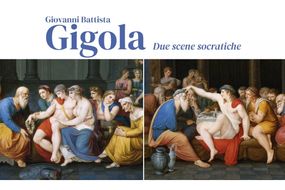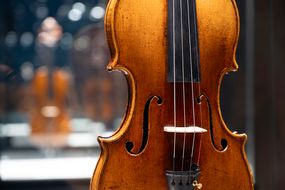From 20 May to 15 August 2025
On the occasion of the celebrations for the 300th anniversary of the birth of Giacomo Casanova, today the exhibition "Giambattista Pittoni and the era of Casanova. Journey in the 18th century between Venice and Naples" was inaugurated at the Royal Palace of Naples, until August 15th.
On display in the Queen's Alcove are three works by the Venetian painter Giambattista Pittoni (1687-1767), some photographic reproductions from the casanovist collection of Aldo Ravà kept at the Library of the Correr Museum in Venice, and materials from the Di Giacomo Fund of the Lucchesi Palli section of the "Vittorio Emanuele III" National Library in Naples.
The three paintings by Pittoni, depicting Venus, Diana, and Apollo (the latter being unpublished), reproduce the voluptuous and mischievously libertine atmospheres against which the human and intellectual events of Casanova unfolded; the works come from the Miari Cumani heirs, descendants of two ancient Venetian families, and belong to a private American collection, the Steven Maksin Family Collection in Las Vegas, Nevada.
The painting of Apollo is completely unpublished, while those of Venus and Diana have been illustrated with two black and white photographs by Egidio Martini, "Venetian painting of the 18th century" (Venice, Marciane Editions, 1964), but considered lost by Franca Zava Boccazzi, who published the reasoned catalog of Pittoni (Pittoni. The complete work, Venice, Alfieri, 1979).
The works were discovered and recognized by the art historian Andrea Donati in 2024, who provided scientific and technical support to the staff of the Royal Palace composed of Elena Carrelli, Antonella Delli Paoli, and Stefano Gei, who were in charge of the curation and setup, in collaboration with the Foundation of Civic Museums of Venice.
The years in which the Venetian Giambattista Pittoni created this mythological painting cycle are also the years in which his fellow citizen Giacomo Casanova visited Naples for the first time, in the first half of the 18th century. The languor of the protagonists in Pittoni's paintings is fully in line with the rococo taste of the time, and with the atmospheres that surrounded the myth of the famous adventurer, who became synonymous with the seducer.
Giacomo Casanova (Venice, April 2, 1725 - Duchcov, June 4, 1798) was a writer, diplomat, scientist, and esotericist, an absolute protagonist of a multitude of erotic seasons from Venice to Naples, where he stayed five times, and where the Casanovist studies of intellectuals such as Benedetto Croce and Salvatore Di Giacomo flourished.
The other materials on display are documents from two scholars, the Venetian Aldo Ravà (1879-1923), collector and scholar of 18th-century art and literature, and the Neapolitan poet and essayist Salvatore Di Giacomo (1860-1934), very different in terms of family background and education, fame, and profession, but both dedicated, almost to obsession, to reconstructing the true history of the events that led the Venetian to travel across half of Europe, and to restoring to his literary work the dignity they believed had been unjustly taken from him by the moralism of subsequent eras.
In the admiration for Casanova by the two scholars, a nostalgia is perceived that refers to the vision of their time: their way of looking reveals much more about their century than about Casanova's, in a play of mirrors and references that almost seems to replicate the interplay of gazes of the protagonists of the three Pittoni paintings mentioned at the beginning.
The Queen's Alcove, on the noble floor of the Royal Palace, is the most appropriate place to exhibit Pittoni's works and the research of Di Giacomo and Ravà: this small 18th-century environment, which follows the architectural layout of the viceregal period, was part of the queen's private apartment along with the two adjoining rooms, the Chapel and the Cabinet. Its intimate refuge character is still readable as such even after the transformations of the 18th and 19th centuries.

piazza del Plebiscito, 1, Naples, Italy
Opening hours
| opens - closes | last entry | |
| monday | 09:00 - 20:00 | 19:00 |
| tuesday | 09:00 - 20:00 | 19:00 |
| wednesday | Closed now | |
| thursday | 09:00 - 20:00 | 19:00 |
| friday | 09:00 - 20:00 | 19:00 |
| saturday | 09:00 - 20:00 | |
| sunday | 09:00 - 20:00 |

From 11 March to 9 January 2026
PTM A/R "Two Socratic scenes" by Giovanni Battista Gigola

Tosio Martinengo Art Gallery, Brescia

From 11 March to 9 January 2026
PTM A/R "The Birth of Venus" by Giuseppe Bezzuoli

Tosio Martinengo Art Gallery, Brescia

From 19 September to 23 November 2025
Masterpieces in Piedmont between the 18th and 19th centuries

Palazzo Madama - Civic Museum of Ancient Art, Turin